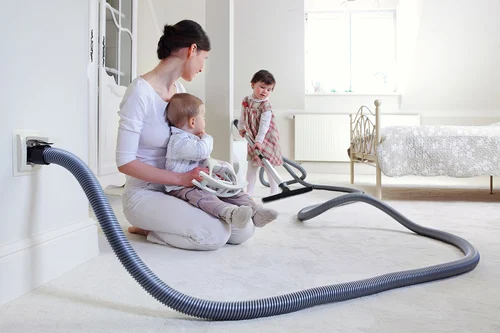Troubleshooting central Central Vacuums can sometimes seem daunting, but with a systematic approach, many issues can be resolved without professional help. Here are some DIY tips for troubleshooting common central vacuum problems:
1. Loss of Suction
- Check Hose and Attachments: Inspect the hose and attachments for blockages or clogs. Use a flashlight to look through the hose and remove any debris with a straightened wire hanger or vacuum hose attachment tool.
- Inspect Inlet Valves: Ensure all inlet valves are fully closed when not in use. Sometimes valves can get stuck open or partially closed, reducing suction.
- Empty or Replace Bag/Canister: If your central vacuum has a bag or canister, check if it’s full and needs to be emptied or replaced. A full bag or canister can significantly reduce suction power.
- Check Filters: Dirty or clogged filters can restrict airflow and reduce suction. Remove and clean or replace filters as per the manufacturer’s instructions.
2. Motor or Power Issues
- Check Power Supply: Ensure the central vacuum unit is plugged in and the circuit breaker or fuse is not tripped. Test the outlet with another appliance to confirm it’s receiving power.
- Reset Circuit Breaker: If the central vacuum unit has a reset button or circuit breaker on the motor unit, press it to reset the system.
- Inspect Motor Unit: Look for any visible signs of damage or overheating on the motor unit. If the motor smells burnt or makes unusual noises, it may need professional servicing.
3. Noise or Vibration
- Inspect Hose and Attachments: Loose or improperly connected hoses and attachments can cause noise or vibration during operation. Ensure all connections are secure and attachments are fitted properly.
- Check for Obstructions: Objects stuck in the hose or within the central vacuum unit itself can cause vibrations or unusual noises. Carefully inspect and remove any obstructions.
- Motor Mounting: Check if the motor unit is securely mounted. Loose mounting can cause vibrations. Tighten mounting screws if necessary.
4. Inconsistent or Intermittent Operation
- Inspect Wiring and Connections: Check for loose or damaged wiring connections, especially at the inlet valves, motor unit, and wall outlets. Tighten connections or repair damaged wires as needed.
- Test Multiple Outlets: Plug the hose directly into different inlet valves throughout the house to determine if the issue is localized to a specific area.
5. Poor Performance on Specific Surfaces
- Adjust Suction Settings: Some central vacuum systems have adjustable suction settings for different surfaces. Ensure the suction setting is appropriate for the type of flooring or surface being cleaned.
- Clean Brushes and Agitators: If using powered attachments, clean any brushes or agitators regularly to remove tangled hair, threads, or debris that may affect performance.
General Tips:
- Refer to the Owner’s Manual: Always consult the manufacturer’s manual for specific troubleshooting steps and maintenance guidelines tailored to your central vacuum model.
- Safety First: Before performing any maintenance or troubleshooting, ensure the central vacuum system is unplugged or the circuit breaker is turned off to avoid electrical hazards.
If you encounter persistent issues or are unsure about performing troubleshooting steps, it’s advisable to contact a professional central vacuum technician for assistance. They can provide expert diagnosis and repair to ensure your central vacuum system operates efficiently.


